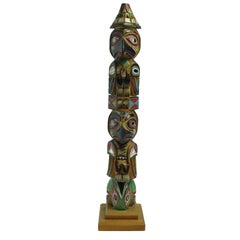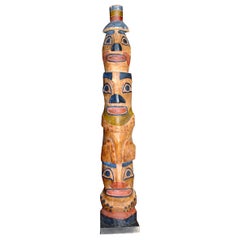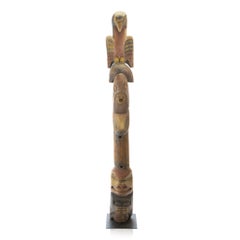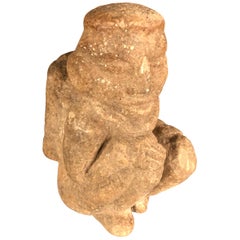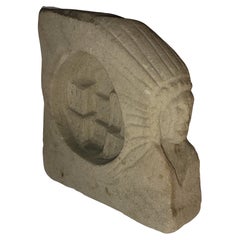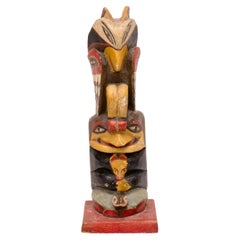Carved Native American Objects
to
22
82
3
95
2
10
1
1
9
10
76
2
14
30
17
3
1
2
4
2
4
2
2
67
26
25
17
7
93
65
25
1
1
97
97
97
22
2
2
1
1
Technique: Carved
Ditidaht/Nuu-Chah-Nulth Totem By Raymond Williams
Located in Coeur d'Alene, ID
Chief Shakes Raven pole by Ditidaht/Nuu-chah-nulth artist Raymond Williams. This finely crafted model totem pole is by Ditidaht/Nuu-chah-nulth master carver Raymond Williams, the father of the current generation of Williams carvers. It depicts an iteration of the Tlingit Chief Shakes pole of Wrangell, Alaska – a popular motif for the Williams family. The top figure is Raven’s Grandfather, who perched on the Box of Daylight. The middle figure is Raven, and below is frog. This model illustrates how Raven stole the sun, moon, and stars and released them into the world. This pole was probably made for Ye Olde Curiosity Shop in the 1950s. 27"
PERIOD: 1950s
ORIGIN: Seattle/Williams Family
SIZE: 27"H
Family Owned & Operated
Cisco’s Gallery deals in the rare, exceptional, and one-of-a-kind pieces that define the history of America and the Old West. Our pieces range from American Indian to Cowboy Western and include original items of everyday life, commerce, art, and warfare that tamed America’s frontier. Our 14,000 square foot gallery opened in 1996 in beautiful Coeur d’Alene, Idaho.
Personal Service
Cisco’s operates on old fashioned values – honesty and integrity, and all of our items are backed by our money back guarantee. We appreciate the opportunity to earn your business. Whether you desire assistance with a jewelry purchase, choosing a gift, identification, or even selling – we hope to be your trusted source.
Totems...
Category
1950s American Native American Vintage Carved Native American Objects
Materials
Cedar
Totem Pole Model Nootka, Northwest Coast
Located in Sharon, CT
Rare, good sized Totem Model. Untouched, original non commercial paint.
Category
Late 19th Century American Native American Antique Carved Native American Objects
Materials
Wood
Nuu-chah-nulth Totem Pole
Located in Coeur d'Alene, ID
While the scale of this carving, at nearly 80 inches tall, may push the limits of the definition of a “model,” the proportions of its figures and it being made for the curio market c...
Category
19th Century American Native American Antique Carved Native American Objects
Materials
Wood
$28,750
Native America Ancient Hand Carved Stone Pipe Idol Sculpture
Located in South Burlington, VT
From Native America and a collection dating to 1951, comes this unique old hand carved stone human effigy pipe figure idol , likely Hopewell culture with its bun head and ear spool...
Category
15th Century and Earlier American Antique Carved Native American Objects
Materials
Stone
$3,600 Sale Price
47% Off
Hand Carved Folk Art Soapstone Indian
Located in Los Angeles, CA
Hand Carved Folk Art soapstone Indian.
Category
20th Century American Navajo Carved Native American Objects
Materials
Soapstone
$396 Sale Price
20% Off
Northwest Coast Totem
Located in Coeur d'Alene, ID
Northwest Coast polychrome totem with multiple bird figures atop a turtle. Hole drilled for clamp. Well painted and carved with bright colors of red, black, blue, white, and brown on...
Category
Early 20th Century American Native American Carved Native American Objects
Materials
Wood, Paint
$4,025
Thomas B. Maracle Indigenous Canadian Mohawk Stone Carving or Sculpture
Located in Hamilton, Ontario
This large Indigenous North American stone carving was done by Thomas B. Maracle of the Mohawk Nation in circa 1985 in his signature Indigenous Folk Art...
Category
Late 20th Century North American Native American Carved Native American Objects
Materials
Stone
Folk Art Inuit Hand Carving of a Man with a Bear in Soapstone C1975
Located in Port Jervis, NY
Beautiful craftsmanship hand carved Soapstone figure of a Man with a Bear.
Detailed and signed on the underside.
Eitger from Alaska or Canada. In excellent vintage condition with min...
Category
1970s Canadian Folk Art Vintage Carved Native American Objects
Materials
Soapstone
$340 Sale Price
20% Off
Yupik Yup'ik Native American Alaska Polychrome Wood Anthropomorphic Spirit Mask
Located in Studio City, CA
A beautiful, somewhat benevolent mask by the Yup'ik (Yupik) aboriginal, indigenous people of South-Western & South Central Alaska. The Yup'ik people, who are related to the Inuit peo...
Category
20th Century American Carved Native American Objects
Materials
Wood, Paint
Early 20th Century Native American North West Coast Eagle Comb
Located in Point Richmond, CA
Early 20th Century Native American North West Coast Eagle Comb
The eagle has a frog in its claws which is “holding” a whale. Carved with classic Nort...
Category
Early 20th Century Canadian Other Carved Native American Objects
Materials
Wood, Paint
Inuit Native American Eskimo Signed Large Stone Carved Tusked Walrus Sculpture
Located in Studio City, CA
A wonderful soapstone large, heavy carving of a tusked walrus by the indigenous inuit people who inhabit parts of the Arctic regions of Greenland, Canada, and Alaska.
Signed on th...
Category
Mid-20th Century Canadian Native American Carved Native American Objects
Materials
Soapstone
Native American Indian Iron Wood Carving Chief Bull Aparoke by Artist Bruce Law
Located in Tustin, CA
"Chief Bull Aparoke" is a legendary work of art from renowned Arizona Native American artist, Bruce Law. Hand-carved from a solid trunk of a rough-hewn Ironwood tree, Chief Bull Aparoke's polished, deeply lined, life size face emerges to evoke the spirit of a stoic Indian Chief who has seen much hardship.
Brass plaque beneath the face reads, "Chief Bull Aparoke Sculpture Bruce Law" and has a carved mark of two intersecting bent arrows.
Measures: 16.5" high x 11" wide x 11 deep. Weighs 27 pounds.
Bruce Law grew up in Phoenix, and now resides in New River, Arizona. Collectors of Bruce’s work include the honorable Barry Goldwater...
Category
Late 20th Century American Native American Carved Native American Objects
Materials
Wood
Vintage Cape Dorset Inuit Stone Carving of a Seal, Unsigned, Canada, C.1960's
Located in Chatham, ON
Vintage Cape Dorset Inuit soapstone (also called Steatite) carving of a seal - featuring fine simplified carving and details accentuating the form of the a...
Category
Mid-20th Century Canadian Folk Art Carved Native American Objects
Materials
Stone
$665 Sale Price
30% Off
Southwestern Native American Signed Hopi Kachina Katsina Doll in Display Case
Located in Studio City, CA
Nicely made and displayed. Signed by the artist on the base.
Kachina figures are believed to act as messengers between humans and the spirit world.
Would be a great addition to any...
Category
20th Century American Native American Carved Native American Objects
Materials
Wood, Paint
Southwestern Native American Hopi Hand Carved Child Cradle Kachina Katsina Doll
Located in Studio City, CA
A wonderfully hand-painted and decorated Native American Hopi Kachina Katsina doll. We believe this was a child's cradle first Kachina doll. It is hand carved from light wood (likel...
Category
20th Century American Native American Carved Native American Objects
Materials
Wood, Paint
Sleepy Mountains Sculpture by RD Tsosie
Located in Dallas, TX
Presenting a gorgeous piece of native American art, namely, “Sleepy Mountains” Sculpture by RD Tsosie, made from polished agate.
By the renowned Na...
Category
20th Century American Native American Carved Native American Objects
Materials
Agate
Yupik Yup'ik Native American Alaska Carved Polychrome Wood Anthropomorphic Mask
Located in Studio City, CA
A fantastic and somewhat grotesquely strange mask by the Yup'ik (Yupik) aboriginal, indigenous people of South-Western & South Central Alaska. The Yup'ik people, who are related to t...
Category
20th Century American Carved Native American Objects
Materials
Natural Fiber, Wood, Paint
American Folk Art Figure
By Som American
Located in Glasgow, GB
This is a very rare example of a mid 19th century Amish childs toy figure. Carved delicately from a lighter weight wood and has been cared for lovingly for the past two centuries . ...
Category
Mid-19th Century American American Colonial Antique Carved Native American Objects
Materials
Wood
$5,892
Yupik Yup'ik Native American Alaska Carved Polychrome Wood Anthropomorphic Mask
Located in Studio City, CA
A fantastic and somewhat playful mask by the Yup'ik (Yupik) aboriginal, indigenous people of South-Western & South Central Alaska. The Yup'ik people, who are related to the Inuit peoples, have a long history of ceremonial mask making. Yup'ik masks were originally and specifically designed by Shamans and made to be worn by these spiritual leaders in Winter tribal dances and sacred ceremonies. Traditionally, the masks were destroyed or discarded after use in these ceremonies. Very few of these masks survived. After Christian contact in the late 19th century, masked dancing was suppressed and the tradition all but died out. As more outsiders settled in Alaska at the turn of the century, masks were made by the Yup'ik people to sell or trade for necessary goods. It is likely that this mask was created some years later for this purpose.
In the 20th century, Yup'ik mask had a profound influence on many renowned surrealist artists including, Max Ernst, Joan Miro, Leonora Carrington, Victor Brauner, and most notably Andre Breton who was an avid collector of Yup'ik masks.
This fantastic anthropomorphic mask is carved of lighter wood, hand painted and decorated with pigment, and held together with natural fiber. The mask seems to represent some sort of smiling, benevolent spirit or character with its four eyes, bird beak, and cat-like ears.
The mask is from a French collection. We were told that this mask, as well as others in the collection we have listed, was acquired originally in the 1950s-1960s in Alaska and the Yukon territory in Canada but as we have no way to verify or authenticate this. Please note we are listing the masks as decorative and not as actual tribal artifacts...
Category
20th Century American Carved Native American Objects
Materials
Natural Fiber, Wood, Paint
Early American Plains Stone Buffalo Hunting Talisman
Located in South Burlington, VT
Native America Plains hand-carved and hand-painted stone Buffalo Hunting Talisman in the form of a buffalo hoof with human effigy head and tail , granite, 1800-1900
Dimensions: 12 inches high and 9.5 inches wide,
Provenance: old mid west collection
Hand-carved with great old paint and patina an authentic old work of art that is likely unique
Lifetime guarantee of authenticity: All of our works of art come with our lifetime authenticity guarantee.
Our gallery has been dealing in authentic Native...
Category
19th Century American Antique Carved Native American Objects
Materials
Granite
Hand Carved Indian Rider Plaque
Located in Los Angeles, CA
This fine hand carved end of the run horse and rider plaque is in great condition.
Category
Mid-20th Century American Adirondack Carved Native American Objects
Materials
Wood
$716 Sale Price
20% Off
Northwest Coast Totem by Marlin Alphonse
Located in Coeur d'Alene, ID
Colorful Alaskan three figure winged totem. Carved and painted by Marlin Alphonse. Noted on back "purchased by Brad and Hazel Ritter on board Royal Princes, Sitka, Alaska 1986. His name heavily carved on back.
PERIOD: 1986
ORIGIN: Alaska
SIZE: 13"H x 12"W x 3 1/2"D
Family Owned & Operated
Cisco’s Gallery deals in the rare, exceptional, and one-of-a-kind pieces that define the history of America and the Old West. Our pieces range from American Indian to Cowboy Western and include original items of everyday life, commerce, art, and warfare that tamed America’s frontier. Our 14,000 square foot gallery opened in 1996 in beautiful Coeur d’Alene, Idaho.
Personal Service
Cisco’s operates on old fashioned values – honesty and integrity, and all of our items are backed by our money back guarantee. We appreciate the opportunity to earn your business. Whether you desire assistance with a jewelry purchase, choosing a gift, identification, or even selling – we hope to be your trusted source.
Native American carvings & totems native American Indian native American totem poles n.
Category
1980s American Native American Vintage Carved Native American Objects
Materials
Cedar
Yupik Yup'ik Native American Alaska Polychrome Wood Anthropomorphic Spirit Mask
Located in Studio City, CA
A fantastic, somewhat sinister appearing mask by the Yup'ik (Yupik) aboriginal, indigenous people of South-Western & South Central Alaska. The Yup'ik people, who are related to the I...
Category
20th Century American Carved Native American Objects
Materials
Wood, Paint
Yupik Yup'ik Native American Alaska Polychrome Wood Anthropomorphic Spirit Mask
Located in Studio City, CA
A beautiful, somewhat benevolent mask by the Yup'ik (Yupik) aboriginal, indigenous people of South-Western & South Central Alaska. The Yup'ik people, who are related to the Inuit peoples, have a long history of ceremonial mask making. Yup'ik masks were originally and specifically designed by Shamans and made to be worn by these spiritual leaders in Winter tribal dances and sacred ceremonies. Traditionally, the masks were destroyed or discarded after use in these ceremonies. Very few of these masks survived. After Christian contact in the late 19th century, masked dancing was suppressed and the tradition all but died out. As more outsiders settled in Alaska at the turn of the century, masks were made by the Yup'ik people to sell or trade for necessary goods. It is likely that this mask was created some years later for this purpose.
In the 20th century, Yup'ik mask had a profound influence on many renowned surrealist artists including, Max Ernst, Joan Miro, Leonora Carrington, Victor Brauner, and most notably Andre Breton who was an avid collector of Yup'ik masks.
This fantastic anthropomorphic mask is carved of lighter wood and hand painted/ decorated with pigment. The mask seems to represent some sort of smiling, benevolent spirit or character.
The mask is from a French collection. We were told that this mask, as well as others in the collection we have listed, was acquired originally in the 1950s-1960s in Alaska and the Yukon territory in Canada but as we have no way to verify or authenticate this. Please note we are listing the masks as decorative and not as actual tribal artifacts...
Category
20th Century American Carved Native American Objects
Materials
Wood, Paint
Ditidaht/Nuu-chah-nulth Totem by Raymond Williams
Located in Coeur d'Alene, ID
(1933-1988) This finely crafted wood totem pole is by Ditidaht/Nuu-Chah-Nulth master carver Raymond Williams, the father of the current generation of William's carvers. The carved totem pole features and eagle, frog, and an orca. Signed on back. Also marked "hand carved Indian made from the Ye Olde Curiosity Shoppe, Seattle, WA 1899." 19"H x 5"
Raymond Williams was the son of Sam Williams...
Category
1950s Canadian Native American Vintage Carved Native American Objects
Materials
Cedar
Mid-Century Era Signed West Coast Cedar Haida Indigenous Canadian Totem Pole
Located in Hamilton, Ontario
This hand-carved cedar totem is signed by an unknown artist and presumed to have originated from Canada and dating to approximately 1960 and done in the West Coast Indigenous Haida s...
Category
Mid-20th Century Canadian Folk Art Carved Native American Objects
Materials
Cedar
Signed Northwest Coast Killer Whale Mask, Attributed to Johnny Johns
Located in Denver, CO
This striking hand-carved wooden mask from the Pacific Northwest Coast powerfully embodies the rich artistic traditions and cultural symbolism of Indigenous coastal peoples. Featurin...
Category
Mid-20th Century American Native American Carved Native American Objects
Materials
Wood, Bentwood
Inuit Sculpture, Bear Attacking Walrus
Located in Palm Springs, CA
A whimsical large Inuit Eskimo carving in soapstone of a Bear holding a rock to throw at 2 Walrus. The tusks of one walrus are likely bone, and th...
Category
20th Century Canadian Carved Native American Objects
Materials
Soapstone
$2,000 Sale Price
20% Off
Antique Folk Art Carved Gesso over Wood and Hand Painted Native Man Statue
Located in Hamilton, Ontario
Presumed to date from the late 19th century, this life-sized Folk Art carved and hand painted study depicts a Native man dressed in traditional attire and holding a staff. The artist is unknown and this sculpture is unsigned and done in a very realistic style. The carving, likely done in Cyprus wood...
Category
Early 19th Century American Folk Art Antique Carved Native American Objects
Materials
Softwood, Paint
$5,995 Sale Price
73% Off
Pair of 18th Century Native American Tobacco Store Hanging Trade Figures
Located in Nantucket, MA
Extremely rare and very special pair of 18th century native American tobacco store hanging trade figures, hand carved in the half round full length figur...
Category
18th Century American Rococo Antique Carved Native American Objects
Materials
Wood
Multi-Figure 7 Foot Nuu-chah-nulth TOTEM
Located in Coeur d'Alene, ID
This large pole was “donated to a church on the northern tip of Vancouver Island for a fundraiser” sometime around 1905. The pole is carved in a folk-art style that is correct for the period. The imagery on this pole is quite fascinating and includes a large bird whose wings form the face of a composite creature holding what appears to be a whale or fish. Below that is what appears to be a Sisiutl, or three-headed sea serpent. Under the Sisiutl is a pair of animal heads flanking the pole, perhaps wolves, over a colonial bald eagle. This pole is a large and early Nuu-chah-nulth totem carving...
Category
Early 1900s American Native American Antique Carved Native American Objects
Materials
Cedar
Pacific Northwest Coast Carved Cedar Killer Whale Rattle
Located in Nantucket, MA
Pacific Northwest coast carved cedar killer whale rattle, by Coastal Salish - Squamish artist Stan Joseph, signed and dated 2012, a beautiful and deeply carved hollow cedar dance rattle in the form of a Killer Whale, with relief carved eyes and mouth, surface striations, and three human faces on the back and tale, with applied pectoral and dorsal fins. Mounted with simple whittled cradle on cedar block base (signed and dated on bottom of base). Hollow interior rattles with entrapped pebbles.
The carving was never polychromed and remains in its original natural finish. Excellent condition.
Stan Joseph is a Coastal Salish artist from North Vancouver. He began carving in 1962 at the age of twelve, and also ventured into painting and designing totem poles. In 1972 he carved an 80 foot and other huge poles which sold to Germany. In 1980 he carved a 60-foot pole for Sea Span and another one for the Chief Joe Matthias Centre, as well as the welcome figure on the West Vancouver Pier. Stan is now an outstanding master carver who teaches his craft to the next generation of young artists. Stan is also accomplished at making silver and gold jewelry, and teaches this art at the employment center.
Stan has been interested in the spiritual dances of the Coast Salish...
Category
2010s American Native American Carved Native American Objects
Materials
Cedar
Kwahu Eagle Kachina Terracotta Totem 78 Inches Tall
Located in Coeur d'Alene, ID
Hopi Kwahu eagle katsina totem. Hand-molded terracotta painted with feathers, turquoise jewelry, beads, shells and other mixed media. Hospoa ro...
Category
Mid-20th Century American Native American Carved Native American Objects
Materials
Wood
Raspberry Alabaster Feather Bundled Bear Fetish with Heart Line
By Amos Pino
Located in Los Angeles, CA
Raspberry Alabaster feather bundled bear Fetish with distinct heart line
Amos Pino
1998
Ramah Navajo Band, Navajo Reservation, El Morro, New Mexico
M...
Category
Late 20th Century American Navajo Carved Native American Objects
Materials
Coral, Lapis Lazuli, Alabaster
Native Nootka Totem by Rick Williams, 2 Foot
Located in Coeur d'Alene, ID
Rick Williams (Nootka / Nuu-chah-nulth, b. 1955). 2 Foot Red Cedar Seattle Pole" painted wood sculpture hand carved by Rick Williams and signed with titl...
Category
20th Century Canadian Native American Carved Native American Objects
Materials
Cedar
19th Century Hand Carved Bark Canoe Bailer
Located in Coeur d'Alene, ID
19th century hand-carved bark canoe bailer from Minnesota. Fur trade era.
Period: 19th Century
Origin: Minnnesota
size: 9" x 6" x 5"
Family Owned & Oper...
Category
19th Century American Native American Antique Carved Native American Objects
Materials
Wood
Pair of Nuu-chah-nulth Model Totems
Located in Coeur d'Alene, ID
This pair of colorful larger Nuu-chah-nulth model totem poles were likely made for a curio shop in Seattle or Victoria sometime around 1915. The poles...
Category
1910s Canadian Native American Vintage Carved Native American Objects
Materials
Cedar
$9,900 / set
Recently Viewed
View AllMore Ways To Browse
Beaded Bandolier
Beaded Indian Moccasins
Germantown Navajo
Indigenous Art Canadian
Native American Bandolier
Native American Eagle Art
Native American Indian Drum
Native American Turtle
Antique Horn Spoon
Antique Indian Drum
Apache Basketry
Coast Salish
Native American Knife
Acoma Pot
Alaska Native Art
Bandolier Bag
Canadian Eskimo Art
Indian Beaded Bag
